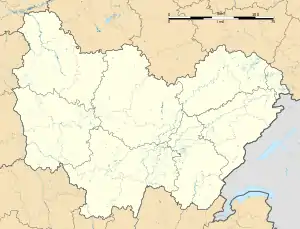Pont-de-Roide-Vermondans | |
|---|---|
 Bridge over the Doubs | |
 Coat of arms | |
Location of Pont-de-Roide-Vermondans | |
 Pont-de-Roide-Vermondans  Pont-de-Roide-Vermondans | |
| Coordinates: 47°23′07″N 6°46′15″E / 47.3853°N 6.7708°E | |
| Country | France |
| Region | Bourgogne-Franche-Comté |
| Department | Doubs |
| Arrondissement | Montbéliard |
| Canton | Valentigney |
| Intercommunality | Pays de Montbéliard Agglomération |
| Government | |
| • Mayor (2020–2026) | Denis Arnoux[1] |
| Area 1 | 13.58 km2 (5.24 sq mi) |
| Population | 4,030 |
| • Density | 300/km2 (770/sq mi) |
| Time zone | UTC+01:00 (CET) |
| • Summer (DST) | UTC+02:00 (CEST) |
| INSEE/Postal code | 25463 /25150 |
| Elevation | 344–817 m (1,129–2,680 ft) |
| 1 French Land Register data, which excludes lakes, ponds, glaciers > 1 km2 (0.386 sq mi or 247 acres) and river estuaries. | |
Pont-de-Roide-Vermondans (French pronunciation: [pɔ̃ də ʁwad vɛʁmɔ̃dɑ̃]; before 2014: Pont-de-Roide)[3] is a commune in the Doubs département in the Bourgogne-Franche-Comté region in eastern France.
Geography
The town is at the heart of the Pays de Lomont, 17 km (11 mi) from Montbéliard at the confluence of the rivers Doubs, Ranceuse, and Roide; it is therefore located at the crossroad of different valleys. On the east end of the town are high cliffs known as les Roches, leading to a plateau near the Franco-Swiss border.
History
In 1973, the adjacent village of Vermondans joined the commune of Pont-de-Roide. In 2013 the fusion was made official by the creation of a new commune: Pont-de-Roide - Vermondans.
Population
| Year | Pop. | ±% p.a. |
|---|---|---|
| 1968 | 5,261 | — |
| 1975 | 5,342 | +0.22% |
| 1982 | 4,958 | −1.06% |
| 1990 | 4,983 | +0.06% |
| 1999 | 4,781 | −0.46% |
| 2007 | 4,619 | −0.43% |
| 2012 | 4,309 | −1.38% |
| 2017 | 4,185 | −0.58% |
| Source: INSEE[4] | ||
See also
- Communes of the Doubs department
- US Pont-de-Roide
- Armand Machabey (1886–1966), musicologist, born in Pont-de-Roide-Vermondans
References
- ↑ "Répertoire national des élus: les maires". data.gouv.fr, Plateforme ouverte des données publiques françaises (in French). 2 December 2020.
- ↑ "Populations légales 2021". The National Institute of Statistics and Economic Studies. 28 December 2023.
- ↑ Décret n° 2014-1447 3 December 2014 (in French)
- ↑ Population en historique depuis 1968, INSEE
External links
Wikimedia Commons has media related to Pont-de-Roide-Vermondans.
- Official Web site (in French)
This article is issued from Wikipedia. The text is licensed under Creative Commons - Attribution - Sharealike. Additional terms may apply for the media files.